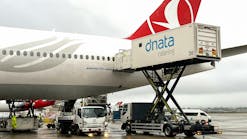The Do’s and Don’ts of Fuel Spill Prevention and Mitigation
A fuel spill of any size is a problem, and regardless of size, a spill should be cleaned up immediately.
“When loss of containment occurs and fuel escapes into the environment, that is when spills can escalate exponentially, and mitigation can cost millions of dollars and can take years to clean up,” says Lee Scott, systems fuel manager with the Inland Group of Companies.
Spills can also lead to environmental issues such as contamination of waterways, wetlands or soil.
The Inland Group of Companies is a multinational collective of aviation services providers. One of these companies is Inland Technologies International/Canada (Inland), specializing in aviation environmental services. On-site training is offered through Inland’s aircraft fueling and fuel farm management services.
According to Scott,he first lesson when learning about fuel spills is recognizing the hazard.
“Fuel transfers always come with a certain element of risk,” he says.
Fuel and fuel vapors can be dangerous to human life and property. Keeping that in mind, Scott says in the event of a fuel spill, consider the following do’s and don’ts:
Do’s
- Protect yourself and your co-workers. If you can help with a situation, stop and risk assess – do not become a casualty.
- Stop the fuel flow, if possible.
- Notify air crew immediately.
- Call for help and emergency response services, if required.
- Protect equipment and assets. Shut down all engines and all possible sources of ignition.
- Protect the environment by preventing fuel from entering drains as it can contaminate waterways, leading to the destruction of wildlife, vegetation and crops.
- Consider the possibility of evacuating the area as a precaution, depending on the size of a spill, and if a building or an aircraft is in a danger zone.
- Understand risks increase in higher temperatures due to being closer to the flash point. Some fuels are higher risk such as Avgas, with a flash point that can ignite easily compared to Jet A1 or diesel. Commingled fuel such as a gas/diesel mix can have a lower flash point.
Do Not
- Do not use a cellphone around fuel. It is dangerous.
- Do not walk through fuel.
- Do not smoke near fuel vents. It is dangerous and extremely unsafe.
- Do not get fuel in your eyes – fuel burns may cause blindness.
- Do not get fuel on your hands. It can cause dermatitis or other skin conditions.
- Do not stand downwind in fuel vapors. Fuel vapors that travel downwind and may accumulate in low points on the ground in a no-wind environment.
- Do not expose yourself to possible respiratory conditions.
While spill response is of critical importance, Scott emphasizes no one should rush in without first assessing risk.
Since the potential of fuel spills cannot always be eliminated, David Deveau, vice president of environmental, health and safety with the Inland Group of Companies, says it is vital that comprehensive spill response procedures and training be part of a risk management approach. A comprehensive approach also should include situational awareness and a robust preventive safety culture in the workplace are critical components, Deveau emphasizes.
“Maintaining focus while transferring fuel is vital,” Scott adds.
Anything that’s done frequently can lend itself to complacency, Scott warns, adding continued vigilance is key to mitigating a possible fuel spill.
“We fuel our cars and other equipment on a daily basis and treat, it in some cases, the same as transferring water into a glass,” he says. “We must always consider the worst-case scenario, what would happen if the nozzle trigger lock didn’t close and the fuel tank overfilled? What if a hose disconnected? What if a fuel connection point parted or an aircraft fuel tank vented? What if the fuel caught fire?”
Risk assessing and knowing the worst-case scenario, identifying when and where it is more likely to happen and what to do if it does can help prevent risk.
In addition, Scott says regular equipment maintenance inspections and toolbox talks on fuel handling procedures are invaluable tools. As best management practices (BMP), Scott says limit the number of hose connections, maintain a clean workplace and ensure that proper personal protective equipment (PPE) is worn.
Inland Technologies takes a proactive approach to workplace safety and believes everyone plays an active role in spill prevention and mitigation.
“We empower our teams to use our electronic safety management system (SMS) tools to report hazards, ‘eye-openers,’ near misses or incidents directly to our EHS team,” Deveau says. “Through daily safety discussions, monthly safety meetings and proactively addressing hazards, we strongly believe our culture is key in spill prevention. Always maintaining a safe workplace, free of hazards, and protecting the environment.”
Spill training is usually company specific and can include fire extinguisher training; spill kit familiarization; notification and response; and live spill response training by utilizing spill kits, boom socks and fuel absorbent materials such as granules and spill pads. There are also many external fuel handling and spill response action courses available online.
“We do annual training and spot training as needed,” Scott says.
Spill response for smaller spills is different than it is for larger spills.
For smaller spills, various products are available such as full spill kits which include boom socks, absorbent granules and spill pads.
“It is also good practice to have granular absorbent and spill pads near all fuel transfer points. When fueling ground support equipment (GSE), spill trays can be used and eliminate nozzle locks so there is no unattended fueling,” Scott says.
After a spill, he says remember to restock the fuel spill carts and ensure the supplies are in good working condition.
Larger spills are defined differently depending on the province or state, airport or customer, but a larger fuel spill can involve the use of a specialized clean-up provider with equipment such as vacuum trucks and operators trained to deal with fuel spill clean-up and monitoring activities.
“Protect people, property and the environment at all times. Stay vigilant, do not become complacent. Maintain situational awareness, it may be others that create a dangerous situation. Always remember your Notification Procedures. Don’t be afraid to ask for help,” Scott emphasizes.
“Focus on prevention but always be prepared to respond to spills, mitigating the impacts,” he adds. “Come home safe.”





